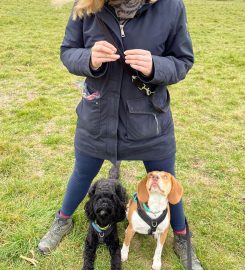Kats and Dogs – Dog Training and Pet Behaviour
About Kat
I haven’t always been a dog trainer, originally I was a media lawyer and spent several years working in various media organisations such as the BBC, Comedy Central, BSkyB and ITV. As a media lawyer I helped structured the best deals so that everyone was happy with the end result. I now use the skills gained within this industry crafting creative strategies to enable me to do the same for my dog training and cat behaviour clients. I’ve always had a strong affinity with animals and it was whilst volunteering in 2012 that I discovered my true vocation! Having been bitten by a feral cat, I decided I really needed to know a LOT more about animal behaviour and to understand how our pets feel and how best to help them. So with a real right turn at the traffic lights style decision my career change journey began and I haven’t looked back since!
Qualifications & Awards
I hold an Advanced Diploma in Companion Animal Behaviour & Training – passed with a grade A Distinction from COAPE 2016. I am also a graduate with distinction from the Victoria Stilwell Dog Training Academy. This six-month intensive course involved working directly with a mentor to improve my technical training skills and also covered human psychology, marketing and how to run a professional dog training business.
Kats & Dogs was nominated and then shortlisted for an Innovation award at the 2018 Greenwich Business Awards for the creative way in which I work with both dogs and their guardians.
Boundaries and Consequences
I often get told that positive training = permissive training. This is not the case, as it is important that your pet knows what behaviour is and is not acceptable.
Sadly they do not speak English and so will only learn by interacting with you and the rest of your family. Clear and consistent boundaries and household rules are very important so that your pet can predict what may happen and therefore relax.
I don’t use aversive methods such as shock collars, spray collars, rattle cans or water bottles as these have been shown to cause increased stress (see research), unpredictable behaviour (see research) and increased incidents of aggression (see research).
Positive training, however, does not mean a lack of consequences following undesirable behaviour. Often the consequence is to make sure that the behaviour is no longer effective – i.e. we have removed the outcome that was causing the animal to repeat the behaviour and we encourage them to do something we do want instead. In my view, pets can be taught consequences without the addition of something which induces fear or unnecessary stress. The trick is to teach them that providing an alternative more desirable behaviour has a positive consequence and therefore makes it more likely to be something they will repeat! Funnily enough I have also found (much to his amusement) that this approach also works with husbands.
FAQs
advice@katsanddogs.co.uk






